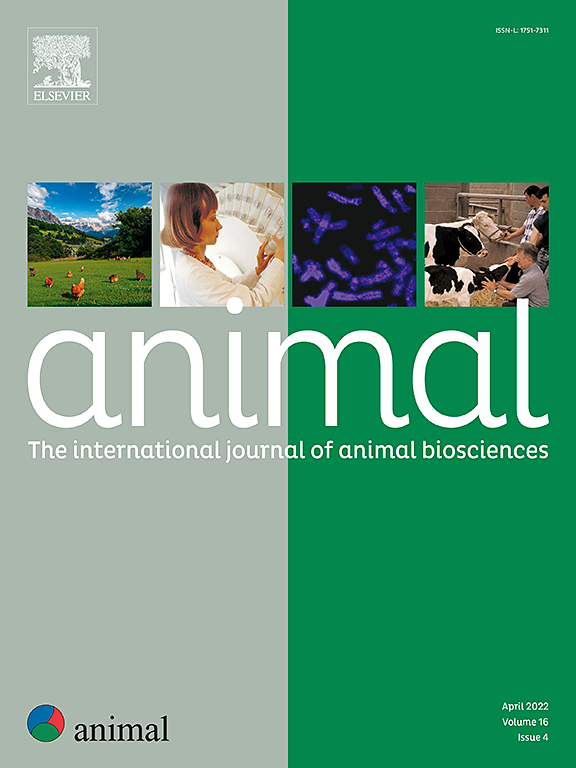Response of maiden ewes to the ‘ram effect’ is a robust management practice and a candidate selection trait for enhanced reproductive performance in drylands
IF 4
2区 农林科学
Q1 AGRICULTURE, DAIRY & ANIMAL SCIENCE
引用次数: 0
Abstract
Management of reproduction that relies on naturally based solutions is extremely important to counter the negative perception around hormone-based interventions. In Mediterranean latitudes and wider regions of non-tropical drylands, sheep do not normally ovulate during spring but exposure to a ram can induce oestrus and ovulation. This study assesses the response of maiden Barbarine ewes in drylands to the ‘ram effect’ during springtime and estimates the genetic parameters of this response. The study uses a database documenting, for 24 consecutive years, the response of nulliparous 18-month-old ewes when mated after stimulation by the ‘ram effect.’ In addition to the oestrous and fertility database, a pedigree database was also available. Nearly half of the maiden ewes responded to the ‘ram effect,’ while 24% exhibited spontaneous reproductive activity and displayed oestrus during the first 14 days following the introduction of rams. Nearly 5% of females did not exhibit oestrus, and these animals are proposed for early culling. Average annual values of Normalised Difference Vegetation Index (NDVI), reflecting vegetation cover, and the percent of maiden ewes spontaneously cycling were positively correlated (P = 0.006). Interestingly, NDVI was negatively correlated with the percentage of anoestrus females that did not respond to the ‘ram effect’ but exhibited oestrus beyond the hypothetical time frame commonly used to describe it. Average fertility was 82.8% and was significantly affected by mating year, live weight at mating, and the response to the ‘ram effect.’ The highest fertility (88.39%) was for females spontaneously cycling at the time of ram introduction, and the lowest (83.35%) was for females coming into oestrus beyond the time frame for a ram-induced oestrus and ovulation. Heritability from a univariate logit-transformed analysis for fertility was 0.10 and the genetic correlation between fertility and the interval between ram introduction and oestrus was 0.26, suggesting that a shorter interval is associated with higher fertility. Thus, the interval between ram introduction and oestrus is a good candidate for selective breeding for high fertility of maiden ewes in drylands mated out-of-season using the ‘ram effect.’
初产母羊对 "公羊效应 "的反应是一种稳健的管理方法,也是提高旱地繁殖性能的一种候选选择性状
依靠自然方法进行繁殖管理对于消除人们对激素干预的负面看法极为重要。在地中海纬度和更广泛的非热带干旱地区,绵羊通常不会在春季排卵,但接触公羊可诱发发情和排卵。本研究评估了旱地中的巴巴丁处女母羊在春季对 "公羊效应 "的反应,并估算了这种反应的遗传参数。该研究使用的数据库连续24年记录了18月龄空怀母羊在 "公羊效应 "刺激下交配时的反应。除了发情和受胎率数据库外,还有一个血统数据库。近一半的初产母羊对 "公羊效应 "做出了反应,24%的母羊表现出自发的生殖活动,并在引入公羊后的前 14 天内发情。近 5%的雌性母羊没有发情,建议将这些母羊提前淘汰。反映植被覆盖度的归一化差异植被指数(NDVI)年平均值与自发发情母羊的百分比呈正相关(P = 0.006)。有趣的是,NDVI 与没有对 "公羊效应 "做出反应但在通常用于描述 "公羊效应 "的假设时间范围之外表现出发情的发情母羊百分比呈负相关。平均受胎率为 82.8%,受交配年份、交配时活体重和对 "公羊效应 "的反应的显著影响。繁殖力最高(88.39%)的雌性是在引进公羊时自然周期性发情的雌性,繁殖力最低(83.35%)的雌性是在公羊诱发发情和排卵时限之后发情的雌性。通过单变量对数转换分析得出的繁殖力遗传率为 0.10,繁殖力与引进公羊和发情间隔之间的遗传相关性为 0.26,这表明间隔越短,繁殖力越高。因此,利用 "公羊效应",公羊引入与发情之间的时间间隔是旱地非季节交配初产母羊进行高繁殖力选育的良好候选条件。
本文章由计算机程序翻译,如有差异,请以英文原文为准。
求助全文
约1分钟内获得全文
求助全文
来源期刊

Animal
农林科学-奶制品与动物科学
CiteScore
7.50
自引率
2.80%
发文量
246
审稿时长
3 months
期刊介绍:
Editorial board
animal attracts the best research in animal biology and animal systems from across the spectrum of the agricultural, biomedical, and environmental sciences. It is the central element in an exciting collaboration between the British Society of Animal Science (BSAS), Institut National de la Recherche Agronomique (INRA) and the European Federation of Animal Science (EAAP) and represents a merging of three scientific journals: Animal Science; Animal Research; Reproduction, Nutrition, Development. animal publishes original cutting-edge research, ''hot'' topics and horizon-scanning reviews on animal-related aspects of the life sciences at the molecular, cellular, organ, whole animal and production system levels. The main subject areas include: breeding and genetics; nutrition; physiology and functional biology of systems; behaviour, health and welfare; farming systems, environmental impact and climate change; product quality, human health and well-being. Animal models and papers dealing with the integration of research between these topics and their impact on the environment and people are particularly welcome.
 求助内容:
求助内容: 应助结果提醒方式:
应助结果提醒方式:


